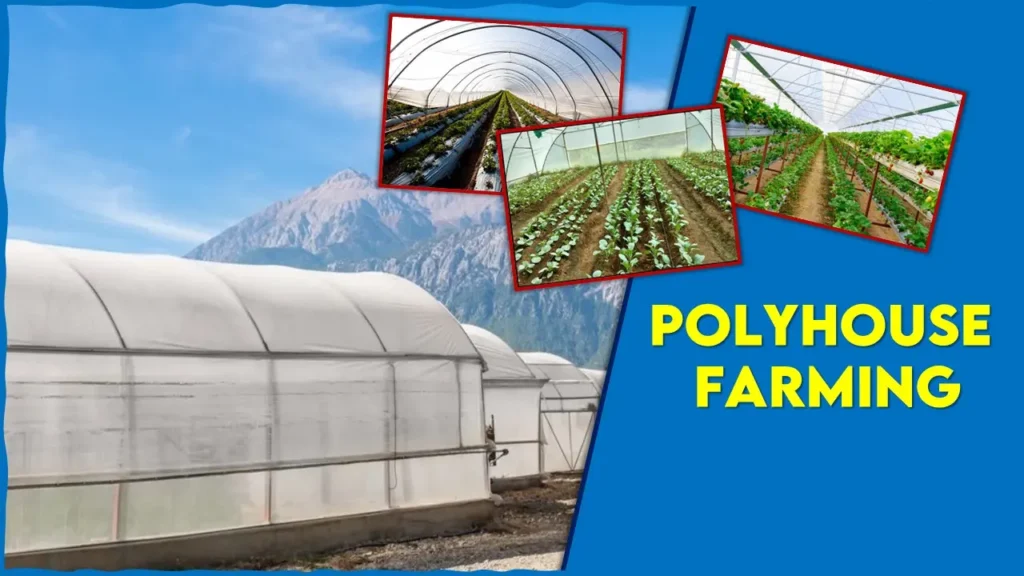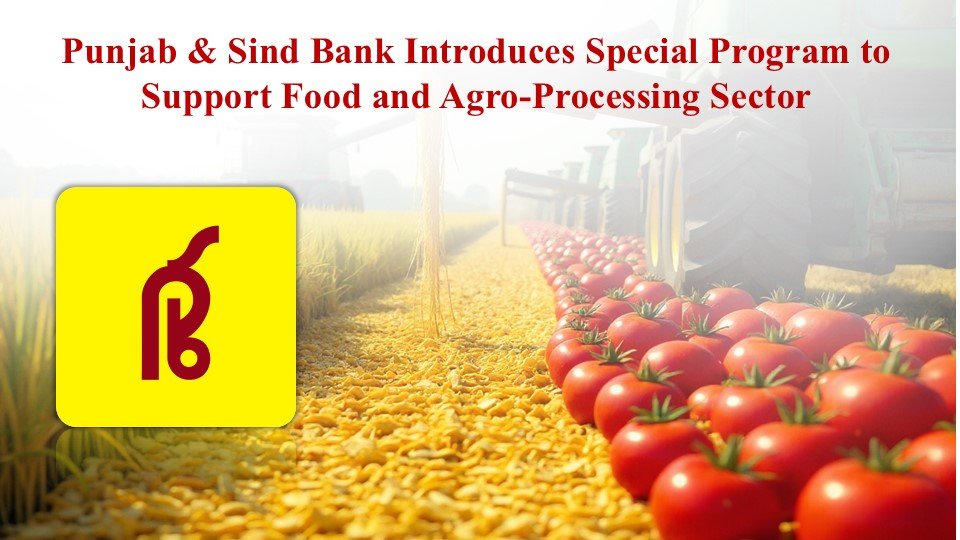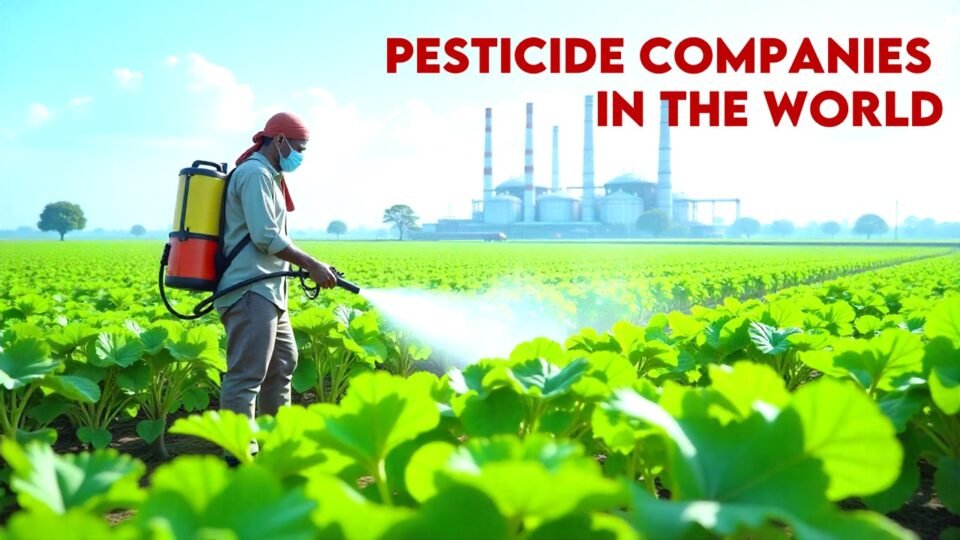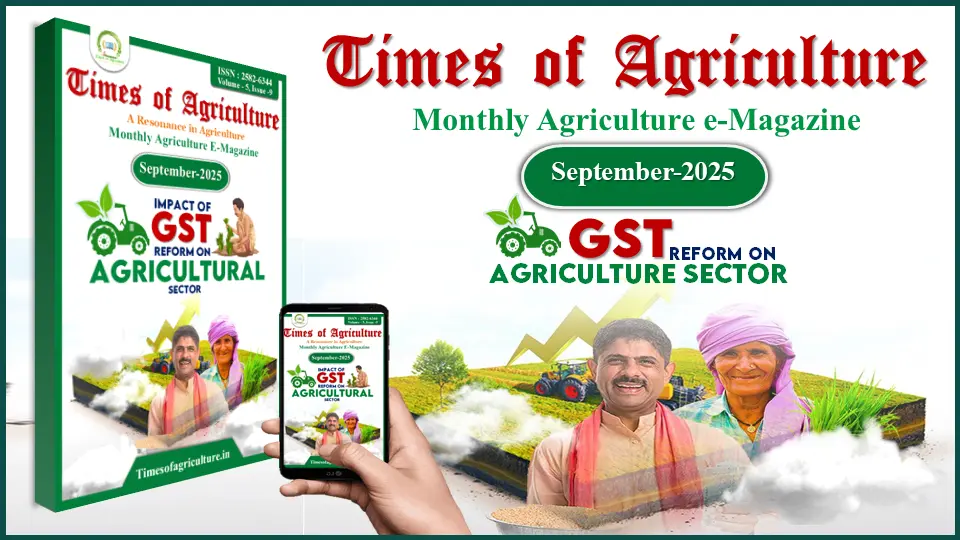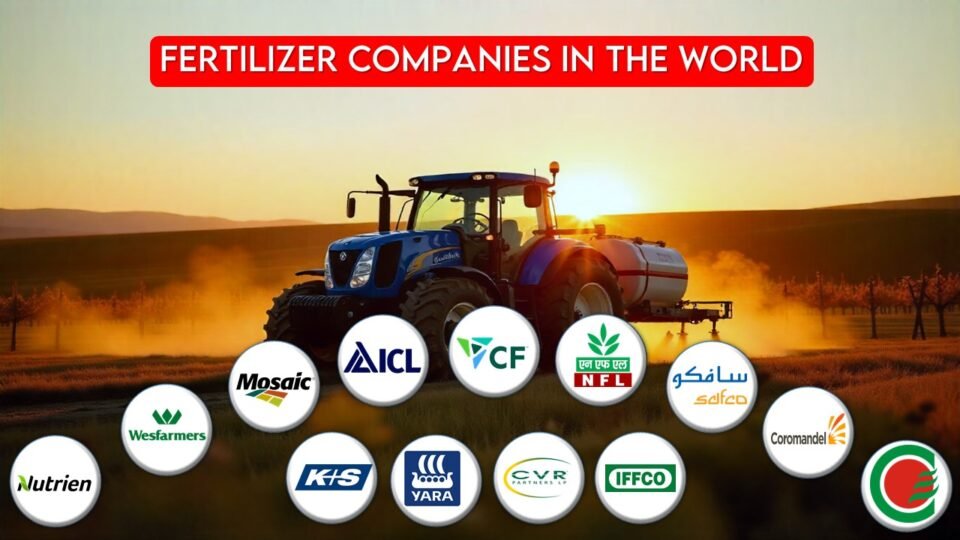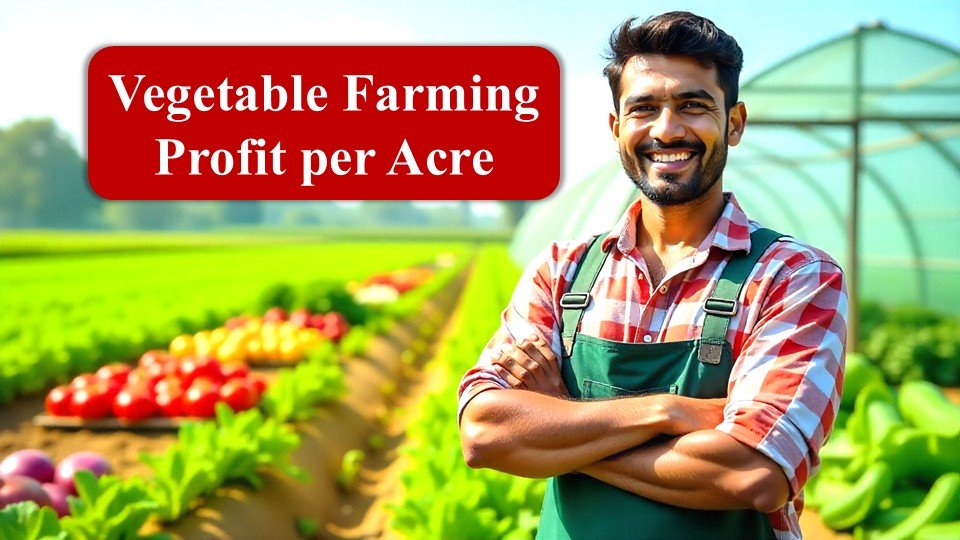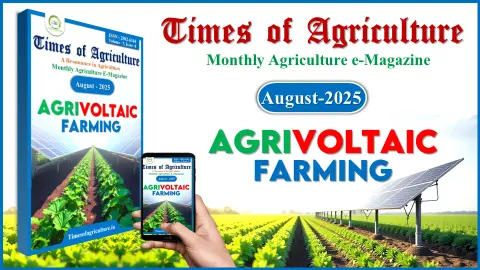Polyhouse farming consists of a well-constructed protected system in which crops are grown in an environment protected from harsh weather conditions, pests, and diseases. Polyhouse farming has proven to be better than conventional farming practices because of its protective environment which in turn, increases the yield.
What is Polyhouse Farming?
Polyhouse farming is a modern agricultural practice that involves cultivating plants within a controlled environment using transparent or semi transparent materials.
These environments are typically made up of plastic or metal frames with transparent walls and roofs. It’s beneficial as compared to open field crops because the returns are good as poly house allows to grow crops throughout the year irrespective of the season. Also, the quality of produce is better than the open field cultivation. The yield under polyhouse or greenhouse cultivation can be achieved to the level of 4 to 8 times as compared to open field crop cultivation.
Different Types of Polyhouse
Polyhouses can be classified based on two parameters: the environmental control system and the construction type.
Based on the Environmental Control System:
1- Naturally Ventilated Polyhouse
This type of polyhouse is the most basic form and relies on natural air circulation. It is designed with vents at the top and sides that allow for the exchange of air. The vents can be opened or closed to control the temperature and humidity inside the polyhouse. However, the control over the internal climate conditions is limited in this type of polyhouse. It is suitable for regions with moderate climates where the external weather conditions are not too extreme.
2- Environmentally Controlled Polyhouse
This type of polyhouse is more advanced and allows for precise control over the internal environment. These polyhouses often include automated systems for irrigation, fertilization, and pest management. However, these polyhouses are more expensive to construct and maintain, and they require a reliable source of electricity to run the control systems.
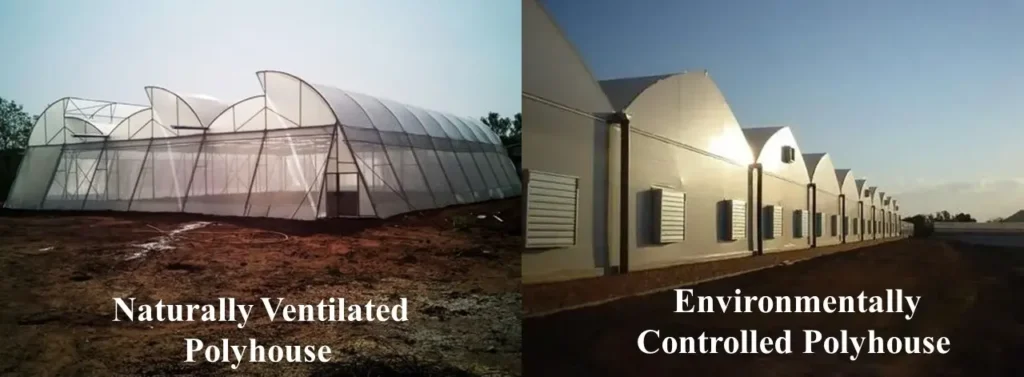
Based on the Construction Type:
1- High-Tech Polyhouse
These polyhouses are built with rigid materials like glass or polycarbonate. The glass or polycarbonate panels need to be cleaned regularly to ensure maximum light transmission, and they may need to be replaced if they get damaged.
2-Moderate Tech Polyhouse
These polyhouses are constructed with flexible materials like polyethylene or PVC. They are less expensive and easier to construct than rigid polyhouses, but they may not last as long.
3- Low-Tech Cheap Polyhouse
This type of polyhouse is simple and cost-effective. They do not provide the same level of control over the internal environment as the other types of polyhouses.
The choice of polyhouse depends on the farmer’s specific needs, including the type of crops to be grown, the local climate, and the available budget.
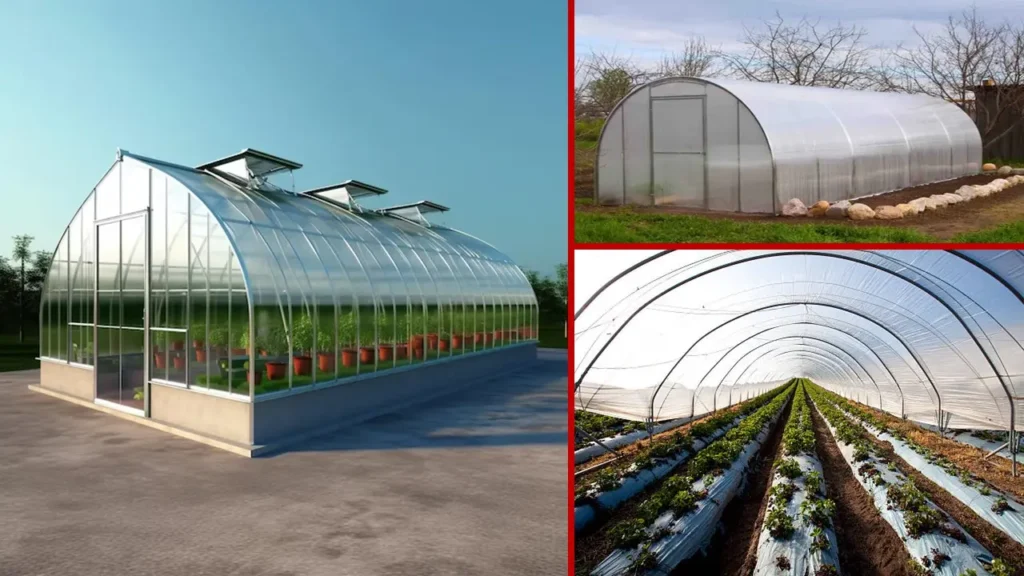
Also Read :
Advantages of Polyhouse Farming
Here are some of the key Advantages of polyhouse farming:
- Controlled Environment: In a polyhouse, plants are grown under controlled temperature conditions, reducing the chances of crop loss or damage.
- Year-Round Cultivation: One of the major advantages of polyhouse farming is the ability to grow crops throughout the year, without having to wait for any particular season.
- Pest and Disease Control: Polyhouses provide a protected environment for crops, reducing exposure to pests and diseases.
- Quality of Produce: The controlled conditions inside a polyhouse can lead to the production of higher-quality crops. The produce grown in polyhouses is often superior in terms of size, color, and nutritional value compared to those grown in open fields.
- Water Conservation: Polyhouse farming often incorporates drip irrigation systems, which can significantly reduce water usage compared to traditional farming methods.
- Increased Yield: Polyhouse farming can increase yield by about 5 to 10 times compared to traditional farming methods. This is due to the optimal growing conditions and the ability to grow crops throughout the year.
- Less Cropping Period: The controlled environment in a polyhouse can accelerate the growth of crops, leading to a shorter cropping period.
- Easy Fertilizer Application: Fertilizer application is easier and can be controlled automatically with the help of drip irrigation in a polyhouse.
Disadvantages of Polyhouse Farming
While polyhouse farming has many advantages, it also comes with certain disadvantages. Here are some of them:
- Limited Control Over Airflow: In a polyhouse, especially in naturally ventilated ones, the control over airflow is limited. This can restrict the farmer’s options in terms of managing the internal climate conditions.
- High Initial Investment: The cost of setting up a polyhouse can be high, particularly for environmentally controlled polyhouses. This includes the cost of the structure itself, as well as the systems for controlling the internal environment.
- Maintenance Costs: Polyhouses require regular maintenance to ensure optimal growing conditions.
- Dependency on Electricity: Environmentally controlled polyhouses depends on electricity to run the control systems. This can increase operating costs and also means that the polyhouse is vulnerable to power outages.
- Cost of Materials and Labor: Naturally ventilated polyhouses can be more expensive in terms of materials and labor due to their taller footprint.
Despite these challenges, with proper management and understanding of the crops’ needs, polyhouse farming can still be a profitable venture.
Polyhouse vs Greenhouse Farming
The comparison between polyhouse vs greenhouse farming has always been a topic of heated debate among farmers. Here is a comparison of both based on various criteria.
| Aspect | Polyhouse Farming | Greenhouse Farming |
| Definition | A polyhouse is a type of greenhouse that uses polyethylene to cover the roof and/or sides of the building to let natural light in. | A greenhouse comprises glass or plastic walls and a roof that traps sun heat. |
| Size | Polyhouses are typically smaller than greenhouses. | Greenhouses are available in a wider range of sizes than polyhouses. |
| Materials Used | Polyhouses are made of plastic sheeting. | Greenhouses are typically made of glass or polycarbonate panels. |
| Cost | Polyhouses are less expensive to construct but may need to be replaced more frequently. | Greenhouses are generally more expensive than polyhouses, especially if made of glass. |
| Mobility | Polyhouses are more mobile than greenhouses because they are made of plastic sheeting that can be easily moved. | Greenhouses are more permanent structures. |
| Climate Control | Both polyhouses and greenhouses can be naturally ventilated or environmentally controlled. | Both polyhouses and greenhouses can be naturally ventilated or environmentally controlled. |
| Durability | Polyhouses are cheaper to start with, but permanent structures like greenhouses are more long-lasting. | Greenhouses are more durable and can last decades with proper care. |
Structure and Design of a Polyhouse
A polyhouse is an agricultural structure that extends for at least part of its length above ground level. It is traditionally constructed from galvanized sheet steel. The structure is supported by timber, concrete, brick, stone, or plastic walls and is accessed by large sliding doors at either end.
The polyhouse features a basic structure with a simple design, making it accessible to both amateur and experienced growers. The frame is covered with polyethylene plastic, creating a controlled environment for optimal plant growth. Compared to a greenhouse, a polyhouse is a smaller version with a polyethylene cover.
The polyhouse is made up of a sturdy frame covered with a transparent material, usually polyethylene, that allows sunlight to enter while maintaining a stable internal temperature and humidity level.
Light Transmission and Insulation in a Polyhouse
In a polyhouse, light transmission and insulation are key factors contributing to the controlled plant growth environment.
Light Transmission: Polyethylene films used in polyhouses offer varying degrees of light transmission. This means that they allow a certain amount of sunlight to pass through and reach the plants inside. The amount of light transmitted can be adjusted based on the specific needs of the crops being grown. However, it’s important to note that the light transmission in a polyhouse can be lower compared to glass used in greenhouses.
Insulation: The polyethylene films used in polyhouses may have UV stabilizers and anti-condensation properties.
Temperature and Climate Control
Temperature Control: Maintaining an optimal temperature in polyhouses is essential for promoting healthy plant growth. Both high and low temperatures can negatively impact photosynthesis, growth rates, and crop yields. High temperatures can lead to excessive transpiration and reduced crop yields, while low temperatures can limit plant growth and increase the risk of frost damage.
Climate Control: An effective climate control strategy in polyhouse farming requires monitoring and manipulating various factors, such as temperature, humidity, light, and CO2 levels. Some advanced polyhouses feature automated climate control systems.
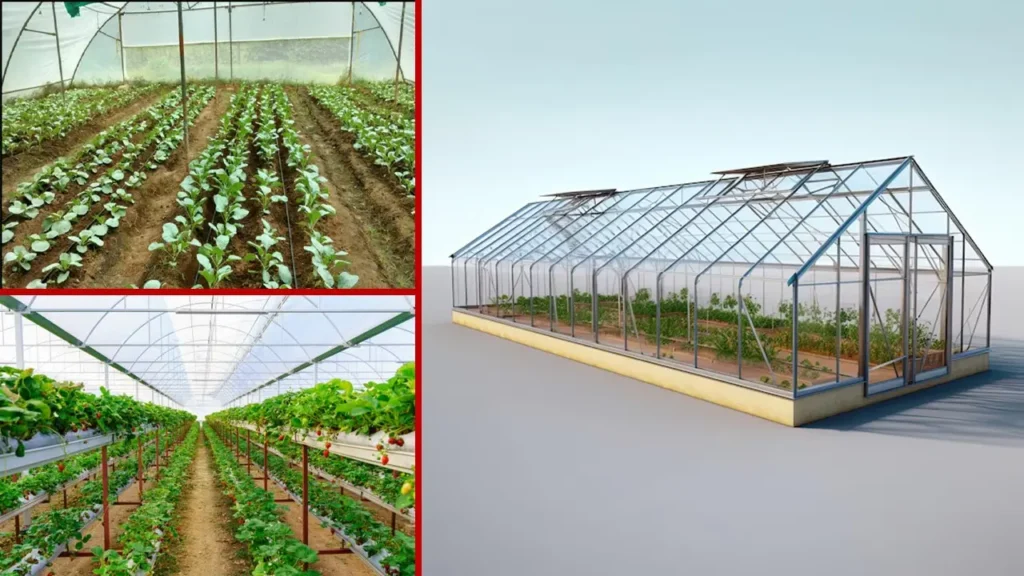
Maintenance and Durability of a Polyhouse
Polyhouses are designed to provide a controlled environment for crop cultivation, but they require regular maintenance and have certain durability considerations.
Maintenance: Polyhouses require routine care, which includes the following activities:
- Replacement of Polyethylene Films: The polyethylene sheets that cover the structure may degrade over time due to exposure to sunlight and weather conditions. These sheets need to be replaced periodically to ensure optimal light transmission and insulation.
- Repair of Damages: Any damage to the structure, such as leaks or tears in the polyethylene film, should be repaired promptly to maintain the optimal climate inside the polyhouse.
- Periodic Cleaning: Regular cleaning is necessary to remove dirt, dust, and pests that may interfere with plant growth.
Durability: The lifespan of a polyhouse is generally shorter compared to greenhouses. While polyhouses are less expensive to start with, permanent structures like greenhouses are more long-lasting.
Now we can look at a very important topic: the cost of setting up a polyhouse in India
Polyhouse Farming Cost in India
Polyhouse farming is a modern agricultural practice involving cultivating plants in a controlled environment. Here’s a breakdown of the Polyhouse farming cost in India:
1. Polyhouse Construction Cost: The cost of constructing a polyhouse can vary greatly depending on the type and size of the polyhouse. Here are some estimates:
- The lowest cost is around Rs. 600 per square meter for a tunnel form polyhouse.
- A naturally ventilated polyhouse without automation ranges from Rs. 800 to Rs. 900 per square meter.
- The cost can go up to Rs. 4000 per square meter for more advanced polyhouses.
- For a 1-acre land polyhouse with a measurement of 100×40 square meters, the total cost could be around 600,000 INR.
Polyhouse Farming Subsidy
The Government of India offers subsidies for polyhouse farming through the horticulture department. These subsidies can significantly reduce the initial investment required for a polyhouse.
Farmers must meet certain eligibility criteria to qualify for the subsidy. These criteria may include having a minimum landholding size and using approved materials for the polyhouse.
The Government of India offers a variety of subsidies to farmers who establish polyhouses. The subsidy amount can reach up to 80% of the project cost. However, it’s important to note that the exact amount can vary from one state to another.
- The National Horticulture Board (NHB) is the regulatory body in India for greenhouse farming. The NHB provides a subsidy of 50% on a project of 112 lakh maximum ceiling per beneficiary.
- The Sub-Mission on Agricultural Mechanization (SMAM) is another initiative that provides financial assistance to polyhouses. The subsidy amount under SMAM 50% of cost (15% higher for hilly areas), Rs. 700/- to 825/- per sqm. for Protected Cultivation Green House, Fan & Pad System (limited to 4000 sq m per beneiciary)
- Eligibility for Availing Subsidy: Polyhouses having an area above 2500 sqm are eligible for subsidy. In the case of the Northeast region, the minimum area is over 1000 sqm.
Equipment: You will require Polythene Sheets, Iron Rods, and other materials. If you want to add technology, it will cost you some extra money.
The exact costs can vary based on various factors such as location, type of crops, and the specific requirements of your polyhouse. Since we have explored the cost breakdown of setting up a polyhouse farm in India, let us now look at the types of crops suitable for polyhouse farming.
Suitable Crops Grown in Polyhouse
Polyhouse or Nethouse farming is a versatile method that allows for the cultivation of a wide variety of crops. Here are some examples of suitable crops that can be grown
| Sl. No | Crop Type | Examples |
| 1 | Vegetables | Tomatoes, Spinach, Green Chillies, Ridge, Bottle, Sponge, Bitter Gourd, Green Beans, Brinjal (Eggplant), Cucumber, Summer squash, Bell peppers, Okra (lady’s finger), Gherkins, Broccoli, Cherry tomato, Yellow and Red capsicum, Lettuce, Red and Chinese Cabbage |
| 2 | Horticultural cut flowers | Gerbera, Rose, Jasmine, Carnations, Orchids, Anthurium |
| 3 | Fruits | Raspberries, Strawberries, Muskmelon, Peach, Papaya, Grapes, Banana |
| 4 | Nursery plants | Ornamental indoor plants, Miniature foliaceous plants, Cacti and succulents, and colorful exotic species. |
These are highly profitable crop that grown in Polyhouses due to the controlled environment which allows for off-season yields and higher production. However, the choice of crop should be based on the local market demand, climatic conditions, and the farmer’s expertise.
Best Construction Site for Polyhouse Farming
Here are some steps to consider when selecting a site for Polyhouse farming:
1. Sunlight: Choose an area with adequate sunlight exposure throughout the day to maximize plant growth.
2. Accessibility: Ensure easy access to the site for construction, transportation, and farm operations.
3. Soil Quality: Conduct soil tests to determine nutrient levels, pH, and texture, which may affect crop growth. Soil remediation or improvement may be necessary, or you may opt for soil-less cultivation methods, such as hydroponics or aquaponics.
4. Water Supply: Ensure access to a reliable and suitable water source for irrigation and temperature regulation.
5. Drainage: Avoid flood-prone areas and plan for adequate drainage to prevent waterlogging, which can negatively impact crop health.
6. Site Elevation: The construction site should be higher than the surrounding land.
7. Contamination: The selected site should be free from contamination.
8. Transportation: Good road facilities should be provided to transport polyhouse produce to nearby markets.
9. Area: It requires a minimum of 1000 square meters of area to build a commercially viable polyhouse.
Also Read:
- Modern Tools Used in Agriculture to Protect Crop from Damage
- Kisan Drone Scheme: Advantages, Cost, Subsidy, Companies
Pollution and Water Stagnation in Polyhouse Farming
Pollution
Polyhouse farming can significantly reduce pollution compared to traditional farming methods. As polyhouses are covered and have a controlled environment, the crops are not affected by unpredictable weather. However, it’s important to ensure that the selected site for the polyhouse is free from contamination.
Water Stagnation
Water stagnation can be a major issue in Polyhouse farming, especially in areas that receive heavy rainfall. The area where the polyhouse is built should not be a low-lying area which will pave the way for waterlogging during monsoon and water release. This can damage the crops. Therefore, the site should be a well-drained area and not a location with waterlogging problems. Extra care should be taken for areas that receive heavy rainfall.
Final Word
Polyhouse farming is a modern farming method that is gaining popularity in India. The fact that polyhouse farming protects against harsh weather conditions, and pest and disease attacks is the reason for the increased attention given to polyhouse farming. Polyhouse farming can decrease the destructive ability of these hazards to a great extent. Hence polyhouse farming is a great farming method that you can try.
Latest Post
- Punjab & Sind Bank Introduces Special Program to Support Food and Agro-Processing Sector
- Beyond Classrooms and Gardens: How a Professor Turned His Passion into Purpose
- October Issue 2025- Times of Agriculture Magazine
- Top 10 Pesticide Companies in the World
- September Issue 2025- Times of Agriculture Magazine
- Top 15 Fertilizer Companies in the World
- Top 10 Vegetable Farming Profit Per Acre in India
- August 2025 : Times of Agriculture Magazine (AgriVoltaics Farming)
- Button Mushroom Farming: Infrastructure, Cultivation, and Profitability


